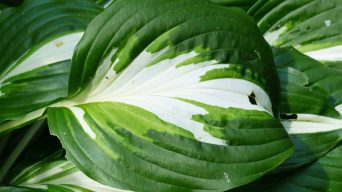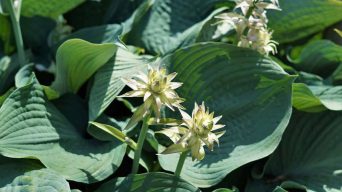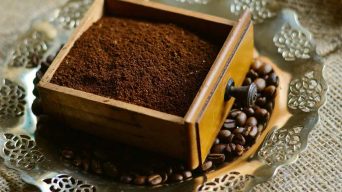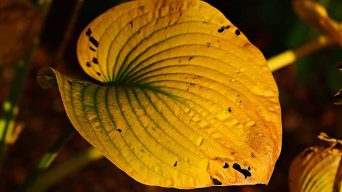Slugs can be a major nuisance for gardeners planting hostas.
Especially in wet and humid climates, these slimy mollusks can quickly take over the plants, leaving behind chewed-off leaves or holes in their stalks.
While it’s not always possible to completely eradicate slugs from your garden, there are some methods you can use to control them and keep your hostas looking healthy.
How To Identify Slugs on Hostas?
Identifying slugs on hostas can be a tricky task. Slugs are small, slimy mollusks that feed off the foliage of hostas and other garden plants.
While they may not seem like a threat to your garden, their damage can make for an unsightly mess.
The tell-tale slime trails and holes in the hosta leaves are the most common signs of slug damage. The slime trails can appear silvery or gray, depending on their age, and will move up and down the leaf in a zigzag pattern. As for the holes, they can range from pinprick size to much larger pieces of missing foliage.
Slugs are typically nocturnal, so you’ll likely find them hiding in the dry mulch during the day or underneath pots and stones during the night. If you’re looking for further proof, try setting some beer traps at night. Slugs love to drink beer and will be drawn to the scent of the trap.
In addition to inspecting for damage, you can also keep an eye out for the slugs themselves. You can usually spot them by their slimy trails, as well as their tiny bodies and antennae. Most species are yellow or brown with a light stripe down their backs.
It is common to mistake slugs for snails, so it is important to watch the differences. Snails have hard shells and come out during the day, while slugs are soft-bodied and nocturnal.
You can differentiate if snails or slugs are eating your hosta plants by the size of their trails. Slugs leave a much larger trail than snails and are more likely to be found among the foliage, hiding in the damp spots from morning dew or rainfall.
Also, snails are likely responsible for the damage rather than slugs if you notice more than one hole in a single leaf. Snails feed in a more linear pattern, while slugs chew around the edges of leaves.
What Does Slug Damage on Hostas Look Like?
Slug damage on hostas can range from minor to severe.
Minor damage typically consists of small holes in the hosta leaves and slimy trails. Severe slug damage usually involves eating a large portion of the plant, leaving it looking patchy and unsightly.
Slugs also tend to destroy young plants more quickly than mature hostas, so keep a close eye on younger plants if you suspect slugs are present in your garden.
How Do You Get Rid of Slugs on Hostas Naturally?
When you find slugs on your hostas, you can use a few organic methods to get rid of them. The most common methods are:
1. Handpicking
Handpicking is the most common method for removing slugs from a hosta plant. It is best to do this in the evening when slugs are most active and use gloves to pick them off safely.
The best way to locate them is to look for their slimy trails. Once you’ve found them, pick them off, drop them in soapy water, or dispose of them in the trash.
2. Planting Slug-Repelling Plants
Certain plants naturally repel slugs, such as marigolds, lavender, and chives. Planting these options near your hosta can help keep slugs away from the area.
This is especially helpful if you have a more extensive garden, which can help keep the pest population down.
3. Setting Beer Traps
This is another common method for removing slugs and snails from your garden. Slugs love the smell of beer and will be drawn to it. All you need to do is place a shallow container filled with beer near the hostas and wait for the slugs to crawl in.
Once they do, empty the container and repeat if needed.
4. Setting Traps with Bait
You can also set traps with bait near your hostas. You can use various baits, such as bread and yeast or a mixture of sugar and baking soda.
The slugs will be drawn to the bait, and you can remove them once they enter the trap.
5. Using Beneficial Nematodes
Beneficial nematodes are microscopic organisms that feed on slugs and other pests.
These can be applied directly to the soil near your hosta, where they will seek out and kill the pests. Nematodes are a great option if you have a larger area to treat, as they can help reduce pest populations over time.
6. Organic Slug Pellets
Organic slug pellets are another effective way to eliminate slugs in your garden. These pellets contain deadly bacteria to slugs but are harmless to other animals and plants.
Sprinkle the pellets around your hosta, water them in, and watch as the slugs disappear.
7. Diatomaceous Earth
Diatomaceous earth is a natural substance made from the fossilized remains of tiny aquatic organisms.
It is a natural, non-toxic powder that is effective against slugs. It works by dehydrating the pests and killing them.
Sprinkle some diatomaceous earth around your hosta and water it in. Mix it with water to create a paste and spread it directly on affected areas.
8. Create Barriers
Lastly, you can create barriers to keep slugs away from your hostas. The most common barrier is copper tape.
Place self-adhesive copper tape around the pot’s rim if growing hostas are in containers or around individual plants. Slugs will not cross the barrier and will be kept away from your hostas.
To create a physical barrier, you can also spread sand, wood ash, or fine gravel around the plants.
How Do You Get Rid of Slugs on Hostas With Chemical Treatments?
A few options are available if you prefer to use chemical treatments to get rid of slugs.
1. Metaldehyde Pellets
Metaldehyde pellets are a common chemical solution for controlling slugs. The active ingredient in the pellets is metaldehyde, which is toxic to slugs and other pests.
You should sprinkle the pellets around the affected areas and water them in. Be sure to follow all instructions on the packaging, as misuse of this product can be dangerous.
2. Iron Phosphate Pellets
Iron phosphate pellets are a safer alternative to metaldehyde. The active ingredient in this product is iron phosphate, which is non-toxic and safe for use around humans, pets, and beneficial insects.
Sprinkle the pellets around the affected areas and water them. Again, follow all instructions on the packaging carefully to ensure safe use.
3. Slug Repellents
Lastly, you can use a commercial slug repellent to keep slugs away from your hostas. This product is safe to use around plants and animals and will not harm the environment.
Spray the repellent around your hostas and reapply as needed.
4. Ammonia
Ammonia can also be used as a slug repellent, but it should be used with caution.
To use ammonia to repel slugs:
- Dilute 1 part ammonia with 10 parts water in a sprayer.
- Spray the leaves and stems of the hostas with the ammonia solution.
- Avoid spraying pure ammonia on leaves or petioles as it can burn them; if it does get on them, wash them off immediately with water.
- Spray the ground around hostas and any shady, damp areas in your garden for maximum effectiveness against slugs lurking thereabouts.
5. Soap and Water
A mixture of soap and water can also be used to repel slugs. Mix a few drops of liquid dish soap in a gallon of water and pour the solution over the affected areas.
The soap will irritate the slugs, causing them to flee from your hosta.
6. Pesticides
Pesticides can be used as a last resort to get rid of slugs. Various products are available, so choose one safe for use around plants and animals.
Follow all directions on the packaging when using pesticides, and take extra care to avoid contact with your skin or eyes.
How To Prevent Slugs on Hostas?
The best way to prevent slugs on hostas is to create conditions that make them less attractive to pests.
Keep Your Garden Clean
Keeping your garden clean and free of debris will help keep slugs away from your hostas.
Remove leaves, weeds, and other clutter that provide hiding spots for slugs.
It would help if you also cleared out any decaying plant matter, as slugs will feed on it.
Water in the Morning
Watering your plants in the morning instead of at night is another effective way to keep slugs away.
Slugs are more active at night and prefer damp, dark places; watering your hosta during the day will reduce their attractiveness to slugs.
When you water them, do so at the base of the plants and avoid wetting the leaves as much as possible.
Increase Sunlight
Increasing sunlight in your garden will also help keep slugs away from your hostas. Slugs prefer shadier, more humid areas; increasing sunshine in your garden will reduce these conditions, making it less hospitable for slugs.
Mulch Your Garden
Mulching your garden will also help keep slugs away. Mulch adds an extra layer of protection around your hosta plant and helps keep the soil dry, making it less attractive to slugs.
Avoid piling the mulch too high around the plants when mulching, as this can provide additional hiding spots for slugs.
Create Barriers
Creating physical barriers around your hostas is another way to prevent slugs from getting to them. Copper strips or mesh screens can be placed around the plants, creating a barrier that will deter slugs from crossing.
Use Companion Planting
Finally, companion planting with certain herbs and flowers can help keep slugs away from your hostas. Plants known to repel slugs, such as fennel and wormwood, can be planted around your hostas; the odors produced by these plants will help keep slugs at bay.
Do Coffee Grounds Keep Slugs Away From Hostas?
Coffee grounds do not have an aggressive effect on slugs and cannot keep them away.
The smell of coffee grounds is not strong enough to deter the slugs from approaching the hostas.
Furthermore, experiments have shown that coffee grounds are ineffective at keeping slugs away from plants.
Will Hostas Recover From Slug Damage?
Hostas will recover from slug damage if you take proper care of them.
The recovery time will depend on how extensive the damage was, with early season damage likely to be healed in a month and later season damage taking until the following year.
The holes in leaves will remain until the end of the season, but tearing off badly eaten leaves can make room for new ones.
Hostas are unlikely to recover if they are repeatedly attacked by slugs, as they do not get enough time to heal before more damage is done.
Additionally, hostas that are located in environments that are not suitable for them may not be able to recover from slug attacks at all.
Final Thoughts
Slugs and hostas can be an annoying combination in a garden. Still, with the proper preventative measures, you can help protect your plants from these voracious pests.
The key is to start early, regularly monitoring for signs of slug infestations and taking proactive steps such as mulching or setting out traps to keep them at bay.
Remember that slugs are essential to a healthy ecosystem, so resist the urge to use chemical pesticides that can harm other beneficial insects or wildlife.
With some vigilance and patience, you should be able to enjoy your beautiful hostas without worry.







